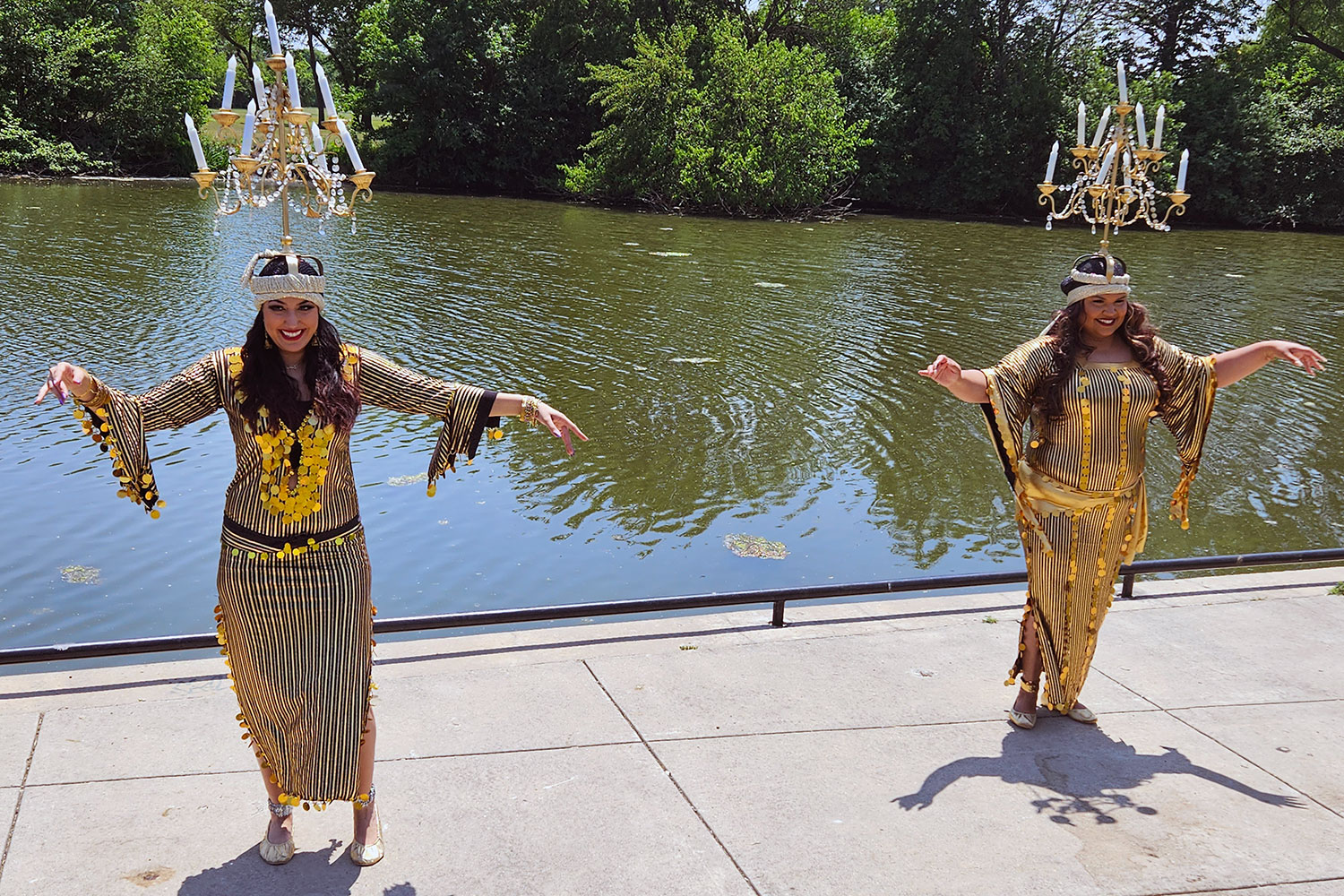Chicago Lawn, on the Southwest Side, was once a starter neighborhood for Middle Easterners migrating to Chicago, especially Palestinians and Egyptians. After putting in their generation in the city, most moved on to the suburbs, like the Poles and Lithuanians who preceded them. Today, Bridgeview, which has one of the largest mosques in Illinois, is the center of Arab-American life in the Chicago area.
Phaedra Darwish, a Palestinian-American dance instructor, wanted to bring the Middle East back to its old neighborhood for a day, an afternoon, an hour. On June 3, she was the emcee and impresario of Raqs Hafla: A MidEast Dance Party, at the Marquette Park lagoon. It was one of the most colorful hours in the history of the Chicago Park District, and perhaps the zaniest, since it featured women dancing with candelabras on their heads.
“Ahlan wa Sahlan,” Darwish greeted the onlookers, who numbered somewhere between a dozen and a score. “You are going to see a variety of dance styles from the Middle East — not just belly dancing.”
(There was belly dancing, however.)
Perhaps you’ve heard the aphorism, “Writing about music is like dancing about architecture.” It is equally true that writing about dancing is like playing the trumpet about architecture. So I took videos of the dancers with my phone. Some information on the four performance clips, in order:
- Jacquelina’s dance and the outfit was a combination of Bollywood and belly dancing. The hipscarf of coins is associated with belly dancing.
- Drum Solo is a conversation between the drummer — depending on what country you are from: darbuka (North Africa), doumbeck (US), derbekke (Levant), tabla (Egypt). The dancer (here, Phaedra Darwish) serves as the vessel of physical expression of the drummer’s riffs and rhythmic solo phrases.
- Raqs Sharqi is the Arabic word meaning “Eastern dance” or belly dancing, as it is known in the U.S. and performed here by Mae the Bellydancer.
- The candelabras that Azeema Malik and Viviana Reyes are balancing on their heads are called shamadan. They’re traditionally used in Egyptian wedding processions, called the zeffah. The shamadan is not the dance style, just the name for the candelabra.
“Marquette Park is very special, because historically speaking, it was the Arab neighborhood,” Darwish said. “A remnant of that is still hanging out.”
That remnant was represented by Ikhlas Hakeem of the Inner-City Muslim Action Network, which is celebrating its 25th anniversary at 63rd and California. Hakeem sat at a picnic table with a collection of ceramics from IMAN’s art therapy program.
“IMAN was founded by Palestinians and African-Americans,” Hakeem said. “It was to strengthen relationships between the communities. The Middle Eastern presence had a negative image. They were running liquor stores, selling tobacco. On 63rd, there was a drought in the community, financially, economically, creatively. IMAN created food resources, job resources, housing.”
Darwish has been teaching Middle Eastern dancing at Candace Dance, 4901 N. Elston Ave., for 15 years. As a second-generation Arab American, her mission is not only to share the dance styles of her ancestors, but to dispel stereotypes of Arab culture from Broadway musicals such as Kismet, and Hollywood movies such as Aladdin.
“These dances cannot be separated from the culture,” she said. “If people of the heritage can express it, it will cease to be a trope.”
As a result of Darwish’s ambassadorship, not all the Raqs Hafla performers were Middle Eastern. Reyes, who danced with a shamadan on her head, is Puerto Rican. Reyes got into Middle Eastern dancing because “I was doing kickboxing and I needed something feminine to balance it out.”
Along with her dance partner Malik, Reyes has performed at the Alhambra Palace Restaurant in the West Loop, where belly dancing is part of the floor show.
“Now I like it way more than kickboxing,” she said. “There’s something so beautiful about it. It embraces you. It’s warm. It’s earthy.”
After the Raqs Hafla dancers went home, a hip-hop show took over the Marquette Park stage. The MidEast Dance Party will continue, though, on June 15 at 6:30 p.m. in Hamlin Park, and July 12 at 6:30 p.m. in Haas Park.
“I want to show Middle Eastern culture and the Arab culture to people who haven’t seen it before,” Darwish said. That means visiting a lot of neighborhoods, far beyond the old Arab heartland of Chicago.



